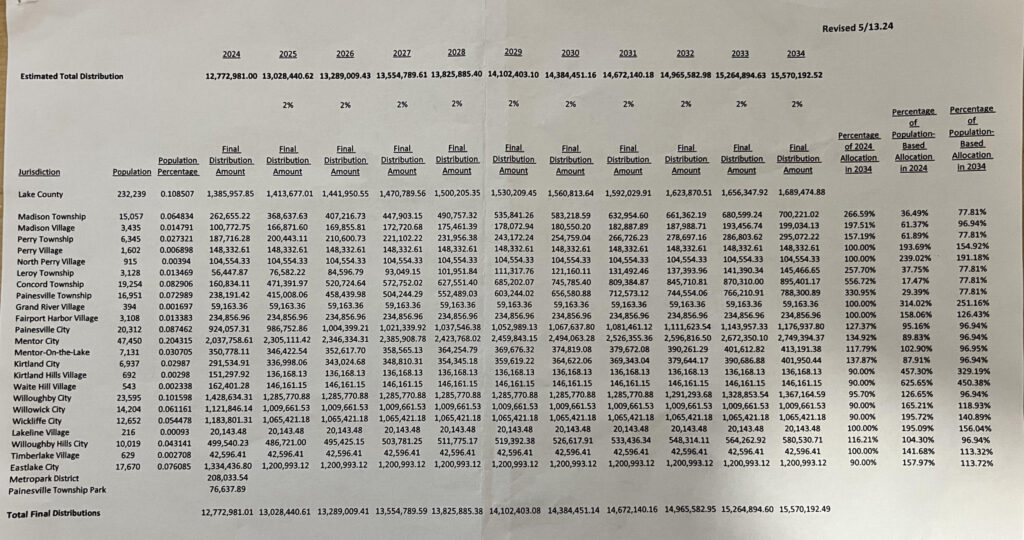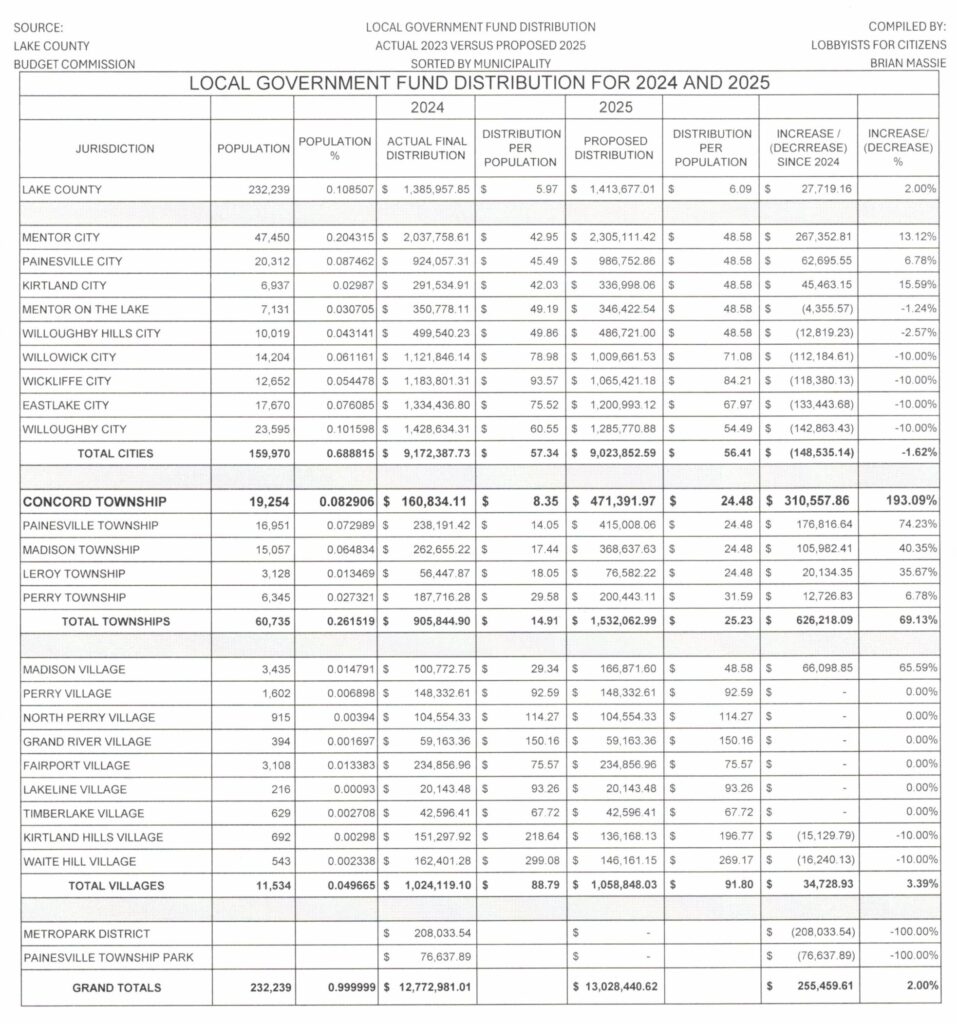By Brian Massie, A Watchman on the Wall
We attended the Lake County Budget Commission meeting held at the Auburn Career Center on May 16, 2024. Per the Ohio Revised Code, the Budget Commission is comprised of the Auditor, Prosecutor, and Treasurer.
The meeting was held to discuss the findings of the Lake County Mayors’ and Managers’ Subcommittee (called an Ad Hoc committee) when the Prosecutor ruled, after being asked by the Commissioners, that the existing alternate formula being used has been incorrect since 2012. The local government funds are monies collected by the State of Ohio from a variety of sources, sales tax, income tax, etc, etc, etc, and after the State takes their administrative fees the balance is distributed back to the 88 counties based on population.
There is a State statutory formula that could be used if the Mayors and Managers could not agree on an alternate formula. According to Auditor Galloway only one County is using the Statutory formula and that is also being dropped. The statutory formula is far too complex and time-consuming for everyone concerned.
On the Ad Hoc committee was Commissioner John Hamercheck, Concord Trustee Morgan McIntosh, Mentor Administrator Ken Filipiak, Willoughby Mayor Bob Fiala, and former Waite Hill Mayor Bob Ranallo. The committee meetings were not open to the public. The average citizen would conclude that the meetings were not open to the public because they did not want input from the public.
The committee decided not to use a “population only” formula because the communities in the western part of the county would suffer a significant decrease in their funding, which would create a financial hardship for them. There was a great deal of debate if the distribution should be based on “need” rather than “population”. However, “need” is quite a subjective hurdle to cross.
Unfortunately, there are no historical documents that could provide some insight to how the 1982 alternate formula was developed. Over the past few decades there has been a population shift in the County where the Townships have experienced a dramatic increase in their population. Using the existing formula has meant that the Townships have been subsidizing the western communities in the County.
The committee created a compromise that would, over a 10 year period, shift the distribution to a greater influence of population. The respective communities are going to have to vote on this proposal by the subcommittee before July 1st, or else the Auditor will have to proceed with the implementation of the statutory formula.

Here is the video of yesterday’s meeting.
LFC’s editorial comments:
Concord Township has been the biggest donor community over the decades. This may not sit well with Concord residents since they have been constantly bombarded with requests for increased property taxes. The Township trustees plan to put yet another levy on the ballot in November, 2024.
The average 30% increase in property values in 2024, taxes collected in 2025, will be a rude awakening for many property owners since they do not even get to vote on the increase because of the impact on the inside millage, and the 20 mill floor, which treats the school district’s outside millage as inside millage.
Concord residents will see the County general fund grow by $1.8 million annually, Concord Township’s general fund will grow by $600,000 annually, and the Riverside School Board will reap a $3.6 million windfall annually, and all without a vote of the taxpayers. It will cost the average Concord taxpayer per $100,000 of market valuation: $11 for the County, $32 for Concord Township, and $93 for the Riverside School District. A total of $136 per $100,000 of market value. The number for the school district is an estimate by the school chief financial officer, and the calculation is a bit complex since the school district is not quite at the 20 mill floor. In other words, it could be much more.
We decided to look a little closer at the numbers, and point out for our readers some interesting statistics. Here is the chart we created comparing the actual distributions for 2024 with the proposed distributions for 2025.

Concord residents should note that in addition to the $600,000 windfall that the Township will get because of the 30% property revaluation, the new alternate formula will add $310,557.86 to the Township’s General Fund in 2025. That is a total of over $910,000, but the Trustees still want to put a levy on the ballot in November 2024.The legacy for Morgan McIntosh that government can never have too much money may haunt him, as he tries to move up the political ladder to Commissioner, State Representative, or State Senator.
When we compare the $ received per person in 2925, we can see that the Townships ($25.23) are still quite far behind the Villages ($91.80) and Cities ($56.41).
The Lake Metroparks District and Painesville Township Park will see their funding cut 100% unless they can “cry the blues” to the Budget Commission’s subcommittee. However, be advised that the Metroparks has $30 million in their rainy day fund and will get approximately $174,000 per year in 2025 without a vote of the taxpayers because of their .1 inside millage. Painesville Township Park should face reality and give the park over to the Metroparks to maintain since they already have a working relationship on the new Lake Erie walking path.
We asked the Metroparks to forgo the $174,000, but they said that they need it to keep the park clean and safe.
Concord residents should note that their Township got $8.35 per person in 2024 (lowest of any municipality) for a total of $160,341. As a comparison, Metroparks got $208,033.54 and Painesville Township Park got $76,637.89! Talk about being used and abused!
In 2024, Waite Hill got $299.08 per person, while Kirtland Hills got $218.64 per person. Our only question is WHY? Why should residents in Concord Township subsidize these two very wealthy communities?
Categories: Lake, Lake County - General, Lake County Politics, Ohio Counties, Uncategorized

Leave a Reply
You must be logged in to post a comment.